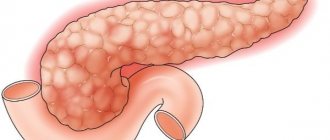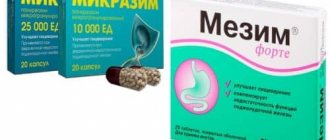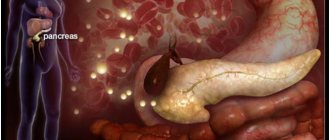Pancreatitis is inflammation of the pancreas. I will tell you about the causes of pancreatitis in dogs and its characteristic symptoms.
You will learn how to provide first aid to a pet and what care for a sick dog involves, what complications arise after an illness and whether there are chances for a full recovery.
In this article I rely on generally accepted information about treatment and nutrition, as well as my own experience working in veterinary clinics. If after reading you still have questions, ask them in the comments.
What is pancreatitis
Pancreatitis is inflammation of the pancreas. The pancreas plays an important role in the digestion process. As soon as food enters the stomach, the pancreas intensively begins to release digestive enzymes into the intestines necessary for the breakdown of fatty, carbohydrate and protein foods. The broken down products are absorbed by the intestinal walls and enter the blood, feeding all the cells of the body with valuable microelements.
When the pancreas is inflamed, the ducts through which digestive enzymes are released are greatly narrowed, and the enzymes cannot enter the intestines, but are activated in the gland itself. The process of self-destruction of the gland begins.
The toxins released during destruction begin to be released into the bloodstream and damage all internal organs. Food that enters the intestines is poorly digested and is partially excreted undigested. The body does not receive the required amount of nutrients and begins to starve.
Sooner or later, the immune system fails. Due to metabolic disorders, the dog develops diabetes mellitus.
Diagnostics
Pathology is difficult to diagnose due to the curved shape of the organ. It is impossible to make a diagnosis at home. At the first signs of digestive problems accompanied by changes in behavior, you should immediately contact a veterinarian. The owner should also be alerted by the dog’s painful, sometimes howling, reaction when light pressure is applied to the stomach in the hypochondrium area. You cannot hope that the dog’s condition will improve on its own, as happens with chronic inflammation, when attacks of exacerbation alternate with periods of remission. A late visit to a doctor often ends in the death of the animal.
By the way!
Pancreatitis is a secret killer, which is often discovered when the functioning of other internal organs is already impaired. Dog owners often seek professional help when the pathology is advanced or has become chronic.
To make a diagnosis, stool, urine, and blood tests are performed: general, biochemical and electrolyte balance. To assess the condition of glandular tissues, the following instrumental studies are prescribed:
- Ultrasound (ultrasonography) of the gastrointestinal tract;
- radiography of the gland and duodenum using a contrast agent;
- biopsy of glandular tissue;
- endoscopic examination using a video camera inserted through a soft tissue incision.
Ultrasound is the most effective examination, with the help of which the disease is detected in 70% of cases. CT is a less productive procedure, so it is not prescribed for dogs, given that the patient needs to be put into medicated sleep.
Abdominal pain or intestinal disorders are not always observed in dogs, therefore, when making a diagnosis, the history and examination of the animal is compared with the results of laboratory and instrumental studies. Autopsy statistics show that dogs suffer from chronic pancreatitis more often than they are diagnosed.
A comprehensive examination is required not only to make a diagnosis, but also to exclude other diseases with similar symptoms: cholecystitis, intestinal obstruction, peptic ulcer, oncology.
Types of pancreatitis
Pancreatitis in dogs is classified according to several parameters: the nature of the disease and the type of appearance.
According to the nature of the course of the disease, they are divided into:
- Acute pancreatitis. The disease is characterized by pronounced symptoms. If you contact a veterinary clinic in a timely manner, the likelihood of your pet’s recovery is quite high.
- Chronic pancreatitis. The chronic form of pancreatitis is most often the result of an acute illness suffered by the dog. Symptoms are mild. If treatment is not started in a timely manner, irreversible changes may occur: diabetes mellitus, necrosis (death) and atrophy (reduction in cell size, disruption or complete cessation of organ function) of the internal organs of the quadruped. Typically, symptoms of chronic pancreatitis become apparent when your pet has less than 30% healthy body tissue remaining. And this inevitably leads to death.
By type of appearance there are:
- Primary form. It occurs as an independent disease that develops as a result of exposure to provoking factors. For example, improperly selected nutrition.
- Secondary form. Inflammation occurs against the background of existing disorders of the body: liver disease, infections, neoplasms, and so on.
Possible complications and prognosis
If treatment for acute pancreatitis is started in a timely manner, the prognosis is favorable. The animal will look clinically healthy if it is provided with gentle exercise and dietary nutrition. Otherwise, exacerbations occur. If there is no treatment, there are 2 options:
- transition to a chronic form;
- death.
If pancreatitis becomes chronic, the following complications occur:
- pancreas necrosis;
- the occurrence of benign tumors with degeneration into malignant ones;
- diabetes;
- ulcers of the stomach and duodenum;
- ascites;
- pulmonary edema;
- arterial thrombosis;
- peritonitis.
The prognosis for the outcome of these diseases ranges from doubtful to unfavorable.
Causes of inflammation of the pancreas
There are many causes of pancreatitis in dogs. Let's list the most common ones.
Poor nutrition
Recently, cases of pancreatitis due to feeding dogs dry food have become more frequent. If you are regular readers of our blog, then you probably know our attitude towards dry food.
Unfortunately, the quality of any dry food, even if it is super-duper premium food, leaves much to be desired. To give the consumer an affordable price, we use not selected meat, as stated on the label, but various waste of animal origin (horns, hooves, sinews, skins, esophaguses, beaks, intestines, etc.), as well as parts of carcasses that were not used on sale for human consumption. I know that many of you will say that this is fiction and speculation... But I can disappoint you - this is the truth. “Veterinary and sanitary requirements for pre-slaughter inspection of animals,” approved by the USSR Ministry of Agriculture on December 27, 1983, clearly describe with what diseases carcasses or other slaughter products that are unsuitable for human food and sent for disposal can be used for animal feed or other needs... These rules are still relevant today. Explore at your leisure if you are interested.
Many people claim that they only buy imported food, which undergoes more thorough quality checks. Nothing like that. Here is a screenshot of a post where foreigners talk about how, after switching the dog to natural food, problems with the pet’s gastrointestinal tract and pancreatitis began to disappear.
In general, no matter what anyone says, it is natural for each of us to eat only fresh and natural food. But even with a natural diet, a dog can develop pancreatitis. Triggering foods include fatty, too salty, spicy foods, and handouts from the master's table. An excess of flour, smoked and fried foods can cause pancreatic diseases. However, this can also be applied to humans.
Obesity and metabolic disorders
Obesity and abnormal metabolism are also usually the consequences of poor nutrition and overeating.
Infectious and viral diseases
Once inside the body, some infections and viruses affect internal organs. First of all, the gastrointestinal tract usually suffers from pathogens. Such infections include parvovirus enteritis, plague, viral hepatitis, adenovirosis, leptospirosis, and so on.
Pathologies of the liver and kidneys
Hepatitis, hepatosis and other liver diseases can cause pancreatitis in a dog. Cirrhosis of the liver in an animal is a seemingly uncommon disease, especially since the pet does not drink alcohol. But the reasons for liver death in animals are completely different. Very often, cirrhosis in dogs develops due to exposure to toxins in the four-legged body. Gallstones can lead to serious complications.
Diseases of the gastrointestinal tract
Gastritis and stomach ulcers can cause the development of pancreatitis in a dog.
Parasitic diseases
The presence of parasites in the body of the mustache weakens the body and increases the risk of developing the disease.
Abdominal injuries
Abdominal injuries and complications after surgery can also cause the development of the disease.
Poisoning
If toxins or poisons enter the body of a four-legged animal, it can cause poisoning of all vital organs. In medicine, this phenomenon is called intoxication. As always, the gastrointestinal tract of the quadruped is the first to suffer. Poisoning (intoxication) can be of various types: food poisoning, poisoning with poisons and chemicals. This also includes drug poisoning. Long-term and frequent use of drugs is dangerous for the body. Under no circumstances should you self-medicate. Especially when it comes to human drugs, which are often prescribed to treat our furry friends.
Causes of the disease
The owner himself is often to blame for a pet’s illness, neglecting recommendations for feeding and care. Lack of vitamins, infection with viruses and parasites, as well as injuries and prolonged stress can lead to quite serious consequences.
Dietary problems or poisoning
The danger is posed not only by a meager diet of dubious and monotonous products, but also by a sudden transition to a new type of food. An equally common cause is poisoning from food from the human table, scraps found in the trash, medicines, household chemicals and other dangerous substances left unattended.
Systemic disorders
This group includes gastrointestinal diseases (gastritis, cholecystitis, cirrhosis), obesity, endocrine disorders (diabetes mellitus, thyroid pathologies, hypercorticism), infection with liver worms and oncology. Here the owner can only influence the lack of excess weight and protection from parasites. Prevention of other pathologies comes down to regular examinations at the veterinary clinic.
Infection with bacteria or viruses
Neglect of vaccination and frequent contact with other animals are fraught with bacterial and viral infections. Complications on the digestive system are caused by parvovirus enteritis, adenovirus, plague and leptospirosis. All these diseases are included in the list of mandatory vaccinations that must be given before the age of one year.
Injuries
Problems with the pancreas occur when the abdominal cavity is injured. In addition to blows and bruises, the cause of organ damage may lie in unsuccessful sterilization or another operation involving dissection of the peritoneum.
Stress
Prolonged exposure to stress factors causes serious psychological disorders. Regularly experiencing negative emotions worsens overall well-being and reduces immunity. All this affects the functioning of internal organs and aggravates chronic diseases.
Genetic and breed predisposition
Pancreatitis is common in small breed dogs. The risk group includes:
- Yorkies;
- toy terriers;
- miniature poodles;
- dachshunds;
- Chihuahua.
All these animals have very sensitive digestion and nervous systems. For them, the cause of chronic pathology can be a one-time handout from the table or a short separation from their beloved owner.
It is also worth noting congenital developmental pathologies associated with abnormal organ structure. These disorders often run in families, so be sure to check the pedigrees of both parents when purchasing a puppy.
Symptoms of the disease
The manifestation of pancreatitis in a dog depends on the nature of the disease. Acute pancreatitis has more severe symptoms. The onset of the disease is similar to a common intestinal disorder.
Signs of acute illness
Typical manifestations of acute pancreatitis include:
- Acute pain in the abdominal area. When palpated to the left of the navel, painful sensations cause the dog to react.
- Loss of appetite, refusal to eat.
- Continuous vomiting, even after drinking water.
- Diarrhea.
- Against the background of constant diarrhea and vomiting, dehydration occurs.
- Breathing is difficult, shortness of breath appears.
- The dog is lethargic and constantly lies down.
- Due to the fact that the body refuses to accept food and water, it becomes depleted, and the four-legged animal loses a lot of weight.
- Despite the general exhaustion, the abdomen is very dense and spherical. The reason for this is severe bloating.
- Violation of the outflow of bile leads to the fact that the mucous membrane of the mouth acquires a yellowish tint.
- Heartbeat becomes more frequent.
- The body temperature normal for the watchdog increases.
Signs of a chronic disease
The symptoms of chronic pancreatitis are less noticeable, but that makes them more insidious. The body slowly deteriorates without obvious symptoms of the disease.
Here are the characteristic signs of chronic pancreatitis in a dog:
- Apathy, lethargy, lack of interest in games and walks.
- Increased urination.
- Poor appetite.
- Isolated cases of diarrhea or vomiting.
- Slow weight loss.
- Gas formation, infrequent bloating.
- Dulling of fur.
- Slight increases in body temperature.
Content
1. Why pancreatitis develops in dogs 2. Clinical picture 3. Diagnosis 4. Treatment of pancreatitis 5. Nutrition for pancreatitis 6. Prevention
Uninformed people believe that a dog’s gastrointestinal tract is more resistant to disease than a human’s. This is a fundamentally wrong opinion. Pancreatitis in dogs, or inflammation of the exocrine pancreas, is a common pathology.
The role of the dog's pancreas
In canids, this organ is shaped like a boomerang. The main part - the central section, or body of the gland - is connected by ducts and blood vessels to the stomach and duodenum.
On average, the length of the organ varies between 20-35 cm, width - 1.5-4.8 cm, thickness - 0.3-1 cm. Weight is 0.2-0.35% of the animal’s body weight, but the significance of this organ not so minuscule. The gland performs 2 important functions:
- Exocrine: produces pancreatic juice, with which the body digests food. It contains 3 main enzymes that break down protein, fats and carbohydrates: protease, lipase and amylase. 95% of glandular tissues are responsible for exocrine function.
- Endocrine: produces insulin, which regulates blood sugar levels. Violation of this function leads to the development of diabetes mellitus.
Due to a lack of enzymes, the body does not receive enough nutrients, causing other organs to suffer - this is the danger of pancreatitis.
How to diagnose the disease
Various methods are used to diagnose pancreatic disease. What tests and procedures the pet will need to undergo is determined by the veterinarian after conducting a visual examination, palpating the animal’s abdominal cavity and determining the symptoms of pancreatitis. Therefore, it is important to carefully monitor the four-legged condition so that nothing is missed during the appointment.
Moreover, the clinical picture of pancreatitis is very similar to other dog diseases: infectious diseases, parasite infection or poisoning.
Basic studies that a doctor may prescribe:
- Blood and urine analysis. As for humans, laboratory blood tests will immediately indicate the presence of pancreatitis. But in a dog they will not give accurate results. But they will be able to tell about the presence of an inflammatory process in the body.
- Ultrasound of the pancreas. The most gentle and painless study that reveals changes in the size of the pancreas and the condition of the ducts. Based on this study, it is possible not only to identify pancreatitis in dogs, but to determine the degree of the disease.
- X-ray of the abdominal cavity. X-rays and ultrasounds reveal the same signs. Therefore, a more gentle ultrasound examination is most often used.
- Gland biopsy.
Pancreatitis in puppyhood
Puppies can also get pancreatitis; this is facilitated by various negative factors, most often infections. Babies who are heavily fed are predisposed to inflammatory processes in the pancreas. Excess weight leads to weakened immunity, malfunctions of internal organs, including the pancreas, and disorders in the digestive system. Feeding puppies should be age appropriate. Due to the imperfection of the gastrointestinal enzyme system, “adult” food is not suitable for them.
The symptoms of acute pancreatitis in puppyhood are the same as in adult dogs. If vomiting, diarrhea and other signs appear, the dog should be taken to the clinic as soon as possible for examination and first aid. A puppy’s body is not able to resist the disease on its own, so the baby may die in a short period of time.
Preventing the development of chronic pancreatitis in a puppy is the primary task of the veterinarian and owner. During the rehabilitation period, the owner must strictly follow the specialist’s instructions: give the animal medicine in a timely manner, feed in accordance with the diet, administer preventive vaccines, and so on.
Treatment of pancreatitis
Treatment is prescribed by a veterinarian based on the diagnostic data obtained. Unfortunately, to date, no drugs have been created that can specifically combat inflammation of the pancreas. Therefore, the main goal of treating pancreatitis is to identify and eliminate the cause of the disease. As well as preventing complications and further maintaining the health of the four-legged animal for the rest of its life.
Treatment of a sick dog includes the following measures:
- Daily fasting is recommended for a sick pet. The dog should not fast for more than 1-2 days. A diet with a minimum amount of carbohydrate foods is prescribed.
- It is necessary to give water to the watchdog in small portions. Read more about four-legged nutrition for pancreatitis below.
- If the body of the tail is dehydrated, physiological solutions are prescribed intravenously or subcutaneously to restore the water-salt balance. The number of droppers depends on the degree of exhaustion of the body.
- For severe vomiting, antiemetic drugs (Cerucal, Ondansetron, Serenia) are used.
- With increased production of hydrochloric acid, to reduce the acidity of gastric juice, drugs such as Famotidine or Omeprazole are prescribed.
- To relieve pain symptoms, antispasmodic and painkillers are used: No-Shpa, Baralgin, Spazgan, Butorphanol. The latter is considered the most effective analgesic for four-legged animals.
- Drug treatment consists of using the drug Contrikal, which is administered intravenously.
- Pancreatin has a good therapeutic effect.
- In addition to the above medications, the animal needs to take enzyme preparations: Mezim, Festal, Enzistal and so on.
- If pancreatitis is the result of an infectious disease, the dog is prescribed a course of antibiotics.
- Throughout the course of treatment, it is necessary to take vitamins and probiotics.
Types and forms of the disease
Pancreatitis is of groups I and II. They are divided according to severity.
Type I is called an acute attack because the disease is activated instantly
in case of poisoning. The irresponsibility of the owner, most often, is the cause of the attack. With a mild form of the disease, the dog will quickly get back on its feet.
Type II – manifests itself under the influence of current diseases:
- Fibrosis and cirrhosis of the liver, hepatitis.
- Stomach ulcer.
- Parasites.
- Ironweed or demodicosis are parasitic mites. They live inside the hair follicle of a mammal.
- Dyskinesia (pathology) of the biliary tract.
- Oncology.
Type II pancreatitis is practically untreatable. The only thing that can be done in such a situation is to maintain the functioning of the pancreas.
Inflammation of the endocrine system organ from an acute form becomes chronic if the animal is not treated correctly. Acute attacks cause severe pain to the dog.
Important! The last type of pancreatitis is pancreatic necrosis. When this stage occurs, the cells of the organ begin to die.
Feeding a dog with pancreatitis
Proper nutrition is an important part of the body's recovery. The diet for pancreatitis is based on the inclusion of easily digestible foods in the diet.
Dogs suffering from pancreatitis and eating dry food are recommended to be switched to natural food. Feeding natural fresh food is physiologically inherent in nature. But the requirements for products are slightly different; after all, the body is weakened and not healthy.
Food should be low-calorie, low-fat, fresh and slightly warm. Food must be offered frequently, but in very small portions. When sick, the number of feedings increases to 5-6 times a day.
If we consider the list of products, it will be:
- Boiled white meat (turkey or chicken). Meat should be boiled, as it is easier for the body to digest.
- Low-fat boiled white sea fish (pollock or cod fillet).
- Vegetables are boiled and crushed to a puree. Vegetables you should offer are zucchini, carrots, and pumpkin.
- Raw vegetables should not be given during illness.
- Low-calorie yogurt without dyes or additives, low-fat cottage cheese.
- Liquid rice cooked in water with rice water.
The dog needs to be given water in small portions approximately once an hour. If you give your four-legged dog a lot to drink, the inflamed pancreas will activate, and the liquid will be rejected by the body. The volume of water offered directly depends on the weight of the animal:
- For a dog weighing up to 10 kg: 1-2 teaspoons of water per hour.
- For a dog weighing 10-20 kg: 1-2 tablespoons of water per hour.
- For a dog weighing 20-30 kg: 100-200 grams of water per hour.
- For a dog weighing more than 30 kg: 300 grams of water per hour.
It is strictly forbidden to offer your dog fried, fatty, spicy and smoked food. Any vegetables and fruits that can cause flatulence should be excluded: cabbage, legumes, corn, fruits. You cannot give baked goods, meat broths, seasonings and additives. Whole milk, sour cream and kefir are also not recommended for feeding. If your pet's menu contains bone components. They should also be temporarily abandoned.
Natural products
List of permitted products:
| Product | Cause |
| Lean meat (beef, veal, rabbit, turkey, chicken) | High protein content helps support a weakened body |
| Fish (navaga, pollock, cod, pike perch) | Supplies the body with fatty amino acids of animal origin, replenishes the supply of vitamins |
| Fermented milk products (cottage cheese, yogurt, kefir, acidophilus, yogurt) | They have a positive effect on digestive processes and supply the body with calcium. |
| Oil (butter, olive, sunflower) | Vegetable fats contain many amino acids and help replenish vitamins. |
| Vegetables (potatoes, carrots, zucchini, pumpkin, beets) | Improves intestinal motility |
| Cereals (rolled oats, rice, buckwheat, semolina) | Have an enveloping effect, normalize the functioning of the stomach |
| Fruits (apple without peel, dried fruits) | Contains vitamins and microelements, benefiting a weakened body |
List of prohibited products:
| Product | Cause |
| Fatty meat (beef, duck, goose, pork) | High fat foods cause indigestion and diarrhea |
| Fish: small river or sea (capelin, roach, sprat) | It is impossible to remove bones from small fish, the digestion process is difficult |
| Dairy products (fresh milk, sour cream, cheeses) | Weakens the stomach, negatively affects intestinal function |
| Fats (lamb, beef, pork) | Inhibits the microflora of the digestive tract |
| Vegetables (corn, lettuce, rutabaga, peas, cabbage, beans, spinach, turnips) | Cause fermentation processes |
| Cereals (millet, barley, wheat) | Irritate the gastric mucosa and contain large amounts of carbohydrates |
| Fruits (citrus fruits, watermelon, pear, raisins) | Contain an excessive amount of coarse fiber, which has a detrimental effect on the intestinal microflora |
Disease prevention
In fact, preventing pancreatitis does not include any super complicated actions. It is much easier to protect your pet than to treat it later. Pancreatitis is a sore of the gastrointestinal tract. Therefore, the most important and most important thing is to provide the furry with a regular and balanced diet.
The dog's diet should not contain any prohibited foods. Which foods should be completely excluded from the diet, and which should be offered in limited quantities, read the article: What not to feed your dog.
Timely vaccination will help protect your four-legged animal from infectious diseases. It is important to visit your veterinarian for an annual checkup. Especially after an illness or when your furry friend is predisposed to pancreatitis. Do not self-medicate under any circumstances. All medications must be prescribed by a veterinarian.
Video
In this video we show how Jack and I go to the veterinary clinic for our annual vaccinations. Although Jekushka is always worried, she endures all the trials and receives a well-deserved reward! If you're interested, you can check it out!
If you are a caring owner and carefully monitor the slightest changes in your dog’s health, this will help prevent or detect the disease in the early stages. Timely seeking medical help will help quickly relieve the symptoms of the disease.
But, unfortunately, it will still not be possible to permanently cure pancreatitis in a dog. Any deviation in nutrition, the slightest piece of forbidden food from the master’s table can provoke deterioration. Therefore, if you adhere to proper feeding of your four-legged, healthy and active lifestyle, then your furry friend will delight you for many, many years.
Good luck and take care of your pets!









